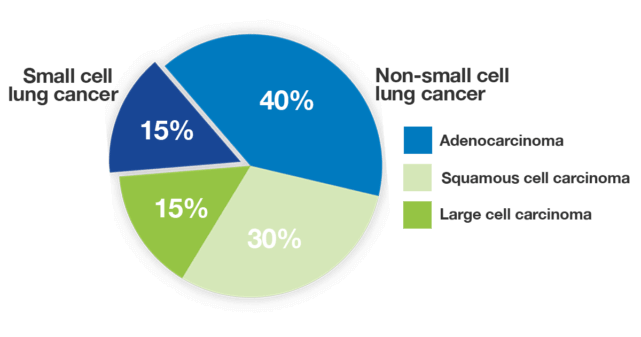Types of Lung Cancer
There are 2 main types of lung cancer. Understanding the differences between each type is critical to treatment decisions and outcomes.
To determine a treatment plan, you need to know what type of lung cancer you have. This is usually determined by having a biopsy.
The type of lung cancer you have is determined by the type of lung tissue the abnormal cells originated in. This is known as the “histology” of the cells.

These broad classifications, based on histology, can greatly affect an individual’s approach and response to treatment.
Non-small cell lung cancer (NSCLC)
Non-small cell lung cancer is the most common type of lung cancer. More than 8 out of every 10 lung cancer cases are NSCLC.
Within the non-small cell lung cancer category, there are 3 subtypes:
- adenocarcinomas
- squamous cell carcinomas
- large cell carcinomas
Adenocarcinoma is the most common form of lung cancer, and begins in the cells in the glands located on the outer part of the lungs. It is most frequently found in women, non-smokers, and people under the age of 45.
Squamous cell carcinomas make up 25 – 30% of all lung cancers and are linked to a history of smoking. Squamous cell carcinomas are more common in men than in women. The majority of cases of squamous cell carcinoma start in the center of the lung. Often, and at an earlier stage than other tumors, squamous cell carcinomas cause symptoms such as coughing up blood.
Large cell carcinomas tend to grow quickly and are usually undetected until they have metastasized. The rarest of the lung cancers, large cell carcinomas only appear in roughly 1 in every 10 cases. As more precise diagnostics have become available, many lung cancers previously diagnosed as large cell carcinomas are being re-classified as adenocarcinoma or squamous cell lung cancer.
A lot of research is being done surrounding treatments for all forms of NSCLC and there are many clinical trials in the pipeline for patients navigating a NSCLC diagnosis.
Small cell lung cancer (SCLC)
Small cell lung cancer is a much less common form of lung cancer, affecting roughly 1 in every 10 people diagnosed with lung cancer. Small cell lung cancer is particularly aggressive. It often returns after initial rounds of chemotherapy.
Because of the Recalcitrant Cancer Research Act, the National Cancer Institute (NCI), in partnership with the lung cancer research community, is making SCLC a major focus of research, resulting in a greater number of clinical trials in the pipeline.

